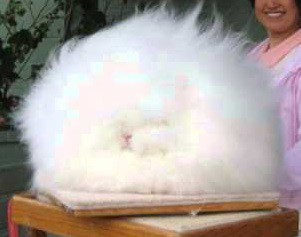Type the name of the breed you're looking for below
[wpdreams_ajaxsearchlite] Don't see the breed your're looking for? Click here and let us know!
Breed Characteristics
1 paw - breed exhibits the least amount of this characteristic
5 paws - breed exhibits most amount of this characteristic
Giant Angora rabbit
| Origin | The Giant Angora is the largest of the ARBA accepted Angora breeds, having been created by Louise Walsh, of Taunton, Massachusetts to be an efficient wool-producing rabbit sustained with 16-18% alfalfa based rabbit feed and hay, and living in the standard size all wire cages used for commercial breeds. The ARBA wouldn't allow German angoras to be shown because their body type was too similar to other breeds, so Louise Walsh made a new breed from German angoras, French lops, and Flemish giants to create a completely different body type. After several years the ARBA accepted it as a breed and it is now showable. Its coat contains three types of wool: soft under wool, awn fluff, and awn hair; the awn type wool exists only on the Giant and German Angora. This breed should have furnishings on the face and ears. Many people confuse German with Giant Angora, but they are not the same. Technically one could show a German angora as a Giant angora since they have German angoras in their pedigrees, however they are unlikely to score well due to the lack of desired body shape. |
Physical Attributes
| Weight | 10 lbs. (4.5 kg) MINIMUM |
| Ear Type | Erect |
| Fur Type | Wooly |
| Colours | Ruby-eyed white, blue-eyed white |
| Appearance | Thick wool covers the entire rabbit, including the face and the stand-up ears, giving in the appearance of a large fuzz-ball. |
| Other Considerations | Life Expectancy: 5 - 8 years Temperament: Docile Like many other "giant" breeds of rabbits, the Giant Angora grows slowly. A doe usually takes more than a year to reach full maturity (size and weight). A buck can take up to 1.5 years to fully mature (size and weight). Because of its long hair takes a long time to dry, it is prone to hypothermia if it gets wet. |
| Best Kept In | Pen, Cage |



